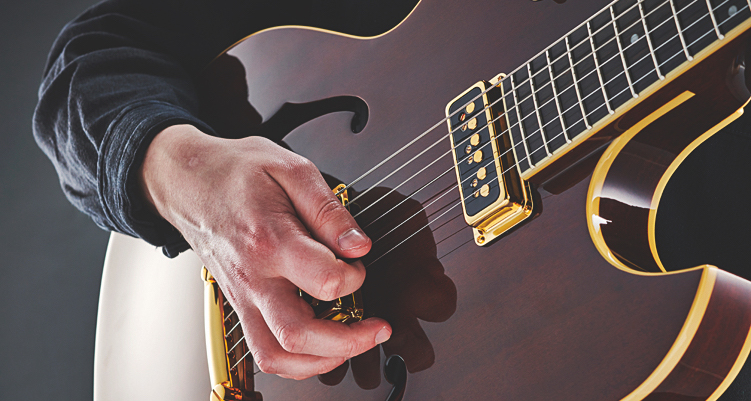Pick Hand Exercises: How to Build Dexterity, Speed, and Accuracy
Get your picking hand clicking with machine-like efficiency.

If your ultimate goal is to be a technically advanced guitarist, you’ll have to get your picking hand and your fretting hand clicking with machine-like efficiency.
In this lesson, we’ll look at exercises that build dexterity for your pick hand.
The best way to achieve maximum results from your pick hand is with alternate picking – picking in a down-up-down pattern. Because this style of picking requires the least amount of hand movement, it facilitates cleaner and faster single-note lines. Use this technique for all of the figures that follow.
Figure 1A is a relatively simple eighth-note exercise on the high E string. Keep your strokes short, using as little motion as possible, and make sure your pick is positioned parallel to the string for each stroke. Also, generate your motion from the ball of the hand/wrist area, not from your forearm or elbow.
Figure 1B uses a melodic sequence similar to Figure 1A, but this time the eighth-note triplets (three even notes in the space of one beat) are the primary rhythmic device. Because of the odd-numbered note grouping, beat 2’s triplets will be picked in reverse order (up, down, up).

Now that you’ve got your basic picking motion down, let’s try a scale sequence on multiple strings.
Figure 2 starts with a quartet of ascending four-note groupings straight out of the A major scale (A, B, C#, D, E, F#, G#). Once you reach the octave of the scale (beat 1, measure 3), the pattern reverses, yielding four descending groupings.
All the latest guitar news, interviews, lessons, reviews, deals and more, direct to your inbox!
Take the figure slowly at first before graduating to the listed metronome settings. Remember, it’s always better slow and clean than fast and sloppy.
After you’ve reached a comfort level with the exercise, try playing through it using different rhythmic groupings, such as triplets or 16th notes.

We’ll close things out with a technique that often presents picking problems for guitarists: string skipping.
Figure 3 hops around the A minor pentatonic scale (A, C, D, E, G) in four-note bursts, featuring string skips in the first three measures of the exercise.
If you’re having trouble gauging the distance between pick strokes during the skips, go over the problem area repeatedly until you’re comfortable with it. Then try the figure as a whole.

Guitar Player is the world’s most comprehensive, trusted and insightful guitar publication for passionate guitarists and active musicians of all ages. Guitar Player magazine is published 13 times a year in print and digital formats. The magazine was established in 1967 and is the world's oldest guitar magazine. When "Guitar Player Staff" is credited as the author, it's usually because more than one author on the team has created the story.
